Thursday, February 19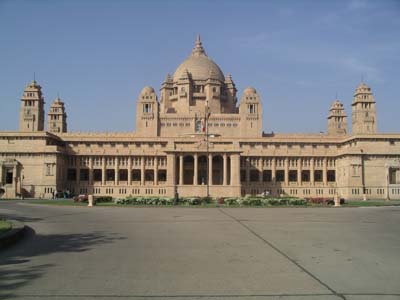
Paula: After a nice breakfast on the terrace of our magnificent
palace where we are "guests" of the King of Jodhpur, we departed
for the winding road that leads up to the Mehrangarth 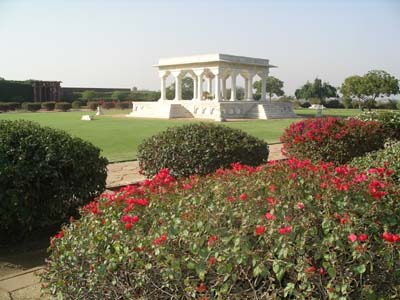 Fort.
Before leaving, we took some more pictures of the palace and its beautiful
grounds. Many tourists come here to the Umaid Bhawan just to see it and take
pictures.
Fort.
Before leaving, we took some more pictures of the palace and its beautiful
grounds. Many tourists come here to the Umaid Bhawan just to see it and take
pictures.
Mehrangarth Fort sits on a perpendicular cliff 400 feet above
the city of Jodhpur and its height, massive size and red sandstone 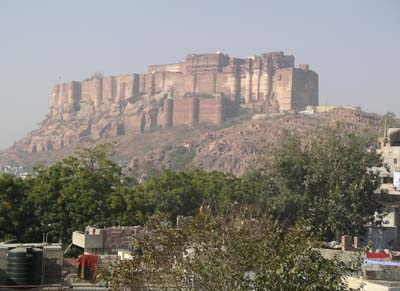 walls
look invincible. The fort was built in 1459 by Rao Jodha, the 15th of the
Rathore dynasty, which controlled this region of India from the 13th to 20th
century. We toured the fort which was opened to the public
walls
look invincible. The fort was built in 1459 by Rao Jodha, the 15th of the
Rathore dynasty, which controlled this region of India from the 13th to 20th
century. We toured the fort which was opened to the public 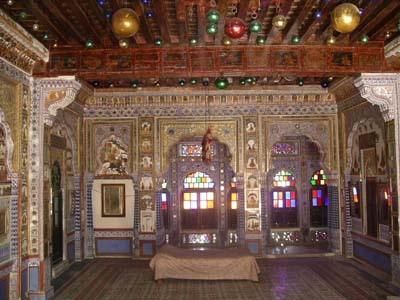 in
1972. We had an opportunity to see many of the rooms used by the kings and
their wives including a beautiful dancing hall and room for the meeting of
the king's ministers. The fort also contains swords, armor, Marwar miniature
paintings on rice paper and mahadols (the boxes used to carry the royal family
on top of elephants. David had a special treat when several men decided to
in
1972. We had an opportunity to see many of the rooms used by the kings and
their wives including a beautiful dancing hall and room for the meeting of
the king's ministers. The fort also contains swords, armor, Marwar miniature
paintings on rice paper and mahadols (the boxes used to carry the royal family
on top of elephants. David had a special treat when several men decided to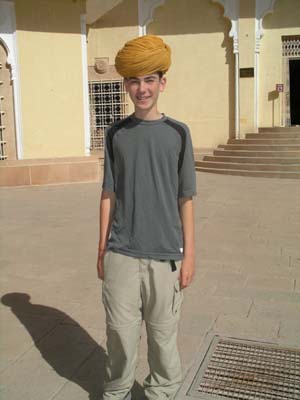 dress him in the traditional Jodhpur head dress - a golden turban!
dress him in the traditional Jodhpur head dress - a golden turban!
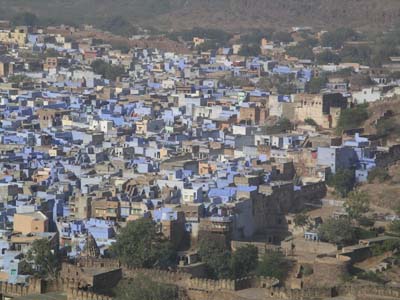 The
view from the top of the fort was incredible. We could see the Umaid Bhawan
Palace where we are staying as well as the beautiful city of Jodhpur below.
Most of the homes of Jodhpur have been painted a brilliant blue which is thought
to keep the city cooler (at least psychologically) during the extremely hot
summers when temperatures are often 45-50 degrees Celsius.
The
view from the top of the fort was incredible. We could see the Umaid Bhawan
Palace where we are staying as well as the beautiful city of Jodhpur below.
Most of the homes of Jodhpur have been painted a brilliant blue which is thought
to keep the city cooler (at least psychologically) during the extremely hot
summers when temperatures are often 45-50 degrees Celsius.
After touring the fort, we visited Jaswant Thada. This is a
memorial and site of cremations for members of the royal family. It is made
of white marble and often referred to as a small Taj Mahal. We were entertained
by many small children at this site who were singing, dancing and playing
music.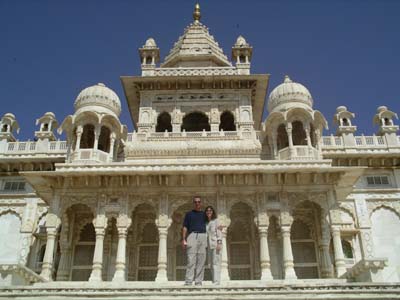
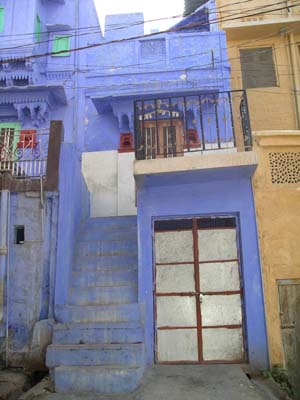
The blue homes of Jodhpur were intriguing and we decided to drive down into
one of the neighborhoods to again walk in the streets. The blue homes here
all belong to members of India's Brahmin caste, the highest caste in India
(it is made up of families whose ancestors were teachers and scholars). School
was just getting out and we quickly attracted a group of children who wanted
to know our names and have their pictures taken. We also saw many beautiful
women, some wearing the traditional nose ring (a large hoop) of Jodhpur. We
have begun to learn how the dress, jewelry, make-up and the colors of men's
turbans distinguish the people of the different regions of India and even
the districts within each region. 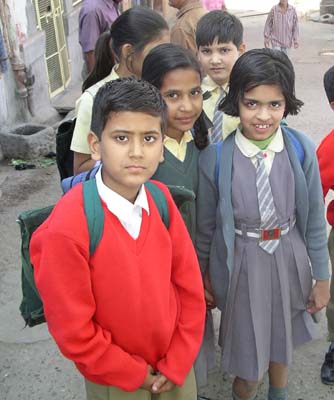
Utpal had a grand plan for the afternoon and after a nice spicy lunch; we
headed to the colorful Jodhpur street bazaar in tuk-tuks. These are small
three wheeled vehicles that most of the local people use to get around. As
usual, the ride was adventurous as we swerved in and out of traffic. Thankfully,
we arrived safely. 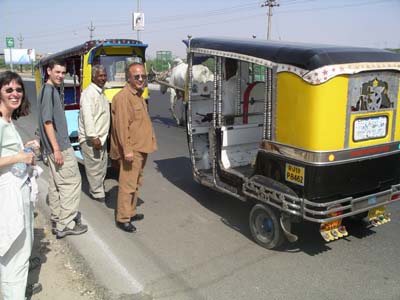 The
bazaar was authentic as promised; instead of tourists we saw hundreds of local
people making purchases of food, clothing and household items.
The
bazaar was authentic as promised; instead of tourists we saw hundreds of local
people making purchases of food, clothing and household items.
Barbers and even dentists were set up in the market. The dentists were particularly
scary - a metal chair behind a proudly displayed set of rusty and dirty tools
on the ground (picture is just below and on the right). We didn't see any
customers today, and wondered whether people really come here to teeth pulled
and repaired as the signs advertise. 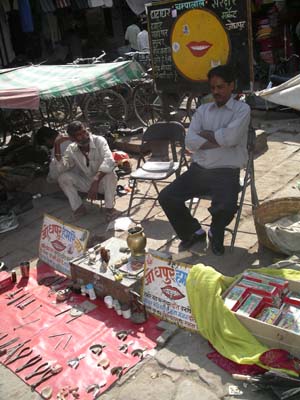
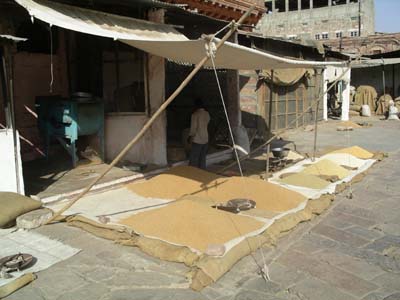 One
section of the bazaar was just for grains and there were large piles of all
different kinds along the road. People were making purchases and placing the
grains in sacks or pots. There were other areas set aside for grinding the
grain into flour.
One
section of the bazaar was just for grains and there were large piles of all
different kinds along the road. People were making purchases and placing the
grains in sacks or pots. There were other areas set aside for grinding the
grain into flour.
We were stopped by many people in the street who wanted to know our names and where we were from. We took several more pictures, and everyone took delight in posing and then seeing their pictures on our camera.
We had fun purchasing spices to bring home - curry, chili pepper, anise candy and Kashmir tea. The kids purchased incense, bangles (the traditional bracelets worn by the women) and a small statue of Sheva (One of the Hindu Gods called the Destroyer). Today is the second day of a Hindu holiday for this God and Utpal told Katie her purchase would bring her good luck.
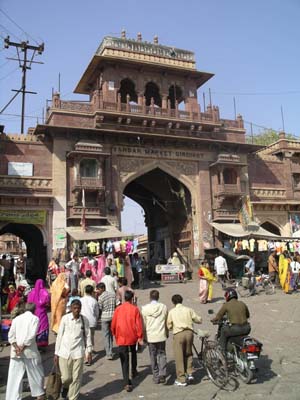
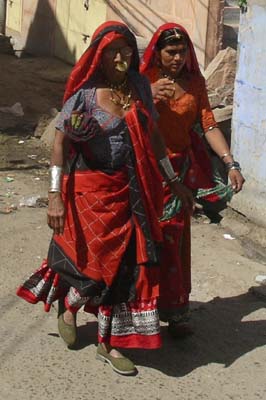
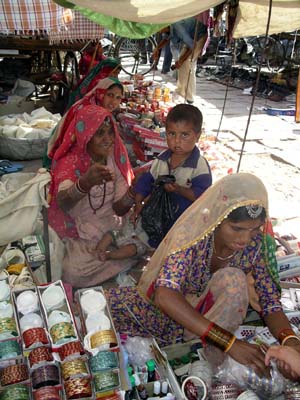
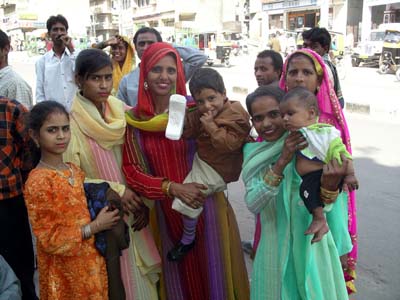
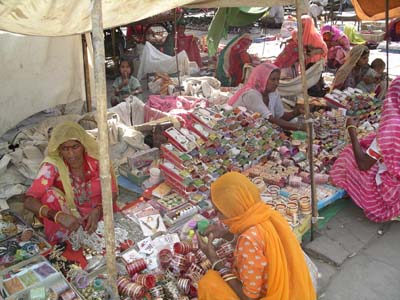
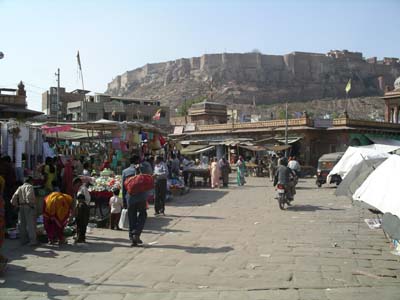
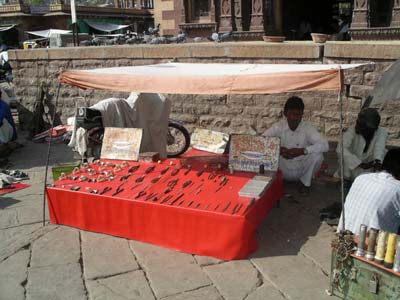
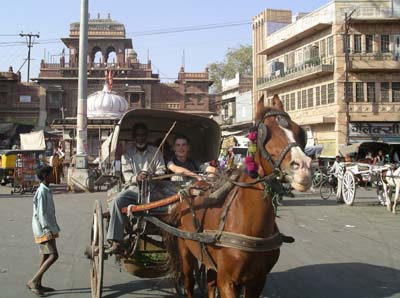
We left the excitement of the bazaar by horse-drawn carriage. I think now
we have taken every form of transportation available! The ride was negotiated
by Utpal, a process that created quite a stir in the bazaar. People smiled
and waved to us as we rode along the road. The drivers of our two carts appeare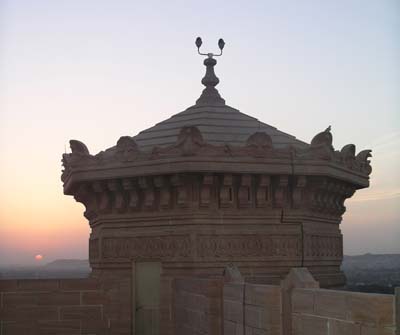 d
to have fun racing toward the hotel palace and at times gained considerable
speed. It was a great way to end another exciting day in India.
d
to have fun racing toward the hotel palace and at times gained considerable
speed. It was a great way to end another exciting day in India.
This evening we were treated to a spectacular sunset from our terrace. Tomorrow we leave Jodhpur and will drive to Jaisalmer, our final and most western destination in India. Jaisalmer is in the Thar Desert, and we have heard that it's very beautiful.
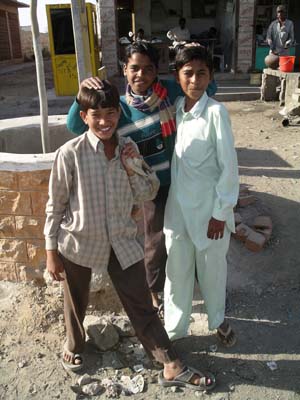
Katie's Kwick Kwacks: The People of India. Throughout our stay here in India, we have been truly amazed by the friendliness and curiosity of the Indian people. Not only have they exchanged smile after smile with us, but in addition have offered us unannounced hospitality, wonderful greetings and acceptance into their communities. The next few paragraphs describe some of my feelings about this remarkable group of people and how they changed our feelings about the country in which they live.
One of the most difficult things to prepare you for life in a foreign country is the attitude and lifestyle of the people. Although we didn't learn too much about the life style of Indians before we came to the country, we knew it would not be a familiar one. We tried to prepare ourselves for the poverty and people living in tough conditions. Although we came to learn that these ideas were accurate, something else surprised us. True, many people seem to be in poor health, and true families and children don't have many personal possessions, but false these people are unhappy, false these people don't laugh, false these people don't smile, and false these people don't enjoy life. They believe it is normal to have to work for survival, normal to have to limit the amount of shopping they do, normal to have to live in tougher conditions. This is their life, and they know no other. We came to realize that even though their way of life is different from ours, it isn't necessarily a bad one. Many of these people are as satisfied with their life as any wealthy family back home. They don't need luxuries to be happy; they live simply and therefore understand the important things in life - education, family, shelter, food, clean water, and health.
One of the most shocking things about being in India, is having everyone staring at you. They don't stare in a mean way, but rather out of curiosity. Some scan your entire body, and you can't help but wonder what they're thinking or chuckling to their friends about. We're guessing things like, "What the heck are they wearing" or "I wonder where they're from." Many people including kids say hello and give us enormous smiles. When we smile back to them they chuckle to their friends, and show off their English skills. It is often difficult to walk quickly in the streets because so many school children want to shake our hand, and ask where we are from. They also love having their picture taken, and like to look in the screen to see themselves on the camera. Ten kids are often all gathered around Dad's little camera, all pointing to themselves on the screen. It is wonderful to feel like we are making their day. Some even walk beside us and stare into our faces - although it was a little uncomfortable at first, we soon realized they are only interested in our foreign looks. Many times there are large groups of school children all making a bet. One child eventually comes forward and quickly asks us our name before running back to show off their gut to the others. A couple of young women even wanted to take a picture of us. We felt like celebrities!
Another thing that really surprises us about the Indian people is their willingness to allow us into their homes for a talk. We basically stop by a random village, see some people walking and ask them to take us to their house. Utpal tells the family who we are and they would always be excited to have us in their home. We learned that this kind of hospitality is strongly encouraged in the Hindu religion. The news eventually spreads and before we know it we are being surrounded by 20-30 Indians from the village. They all greet us and ask some questions about where we are from, what grade David and I are in, etc. They are all so friendly and welcoming, even though we are very foreign to them. Everyone wants to be in a photo, and they all try to get as close to us as possible. We learn a lot about village life from these experiences, and get to see typical Indian houses and farms.
All in all, the people of India have been unbelievably welcoming and friendly
to us, and their warm hearts and acceptance of their lives has helped us to
understand and appreciate life in India to the fullest. 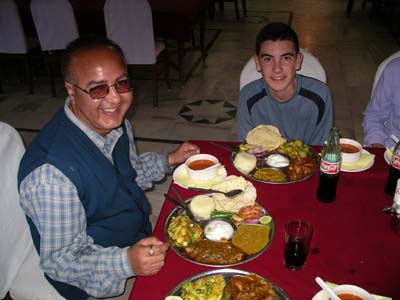
David's Daily Dumps: Indian Food. Indian food is absolutely amazing! It has made my favorite foods list along with Italian and Turkish cuisine. It is so delicious and mouth-watering! One of the beauties of Indian food is that it looks unappealing but is actually really tasty. The names of the food are also not always appealing, but they're often a wonderful treat!
The main staples of Indian meals consist of mutton (goat), lentils (beans), and vegetables (depending on the season: now cauliflower is in season), rice, roti or nan (pita-like bread), chicken, and some sort of cheese (yoghurt or cottage cheese). Lunch and dinners almost always include these staple foods. We occasionally take breaks from these meals and go with continental foods such as pasta when we are looking for a change.
Our first Indian meal at a restaurant was a great experience. We had no idea what we were going to get. Utpal recommended that he order for us since he knew all the best dishes at the restaurant. When the waiter came with a big tray of steaming foods I couldn't wait to fill my stomach. That's when I saw what was in the bowls. The food looked like multicolored mush! I couldn't pick out what I wanted and didn't want; I got two spoonfuls of each kind of mush. I got lumps of cheese covered in a thick green gravy, beans in a brown sauce, a kind of cauliflower and pea paste, lumps of mutton (the only thing that looked appetizing), and a lot of white rice. I have many friends who live on pizza and pasta, and I was wondering what they would say as I dug into this meal. They would never even touch any food that was green! Although I was a little hesitant at first, I eventually tried everything and loved it. I liked it so much that I cleaned my plate with bread and finished every last grain of rice!
One of the things that I am really missing right now is beef. Hindus believe the cow is sacred and are against eating it. That's why there is so much chicken on all the restaurant menus (which we are staying away from eating because of the bird flu). In fact many Hindus are vegetarians and eat no meat at all.
Indian food is definitely one of my favorite foreign foods, and I am looking forward to trying real Vietnamese, Chinese, and Japanese food in the future.
